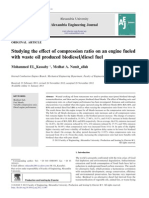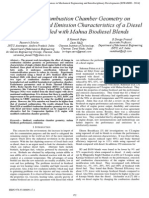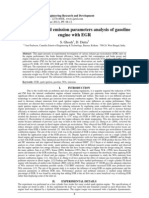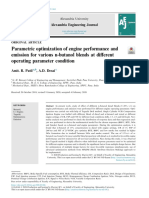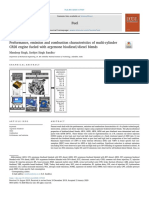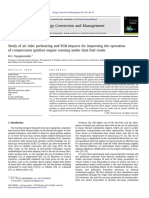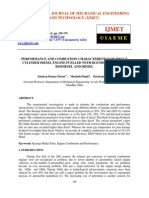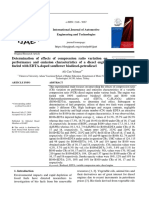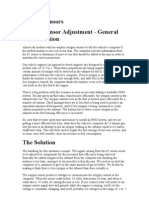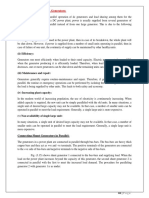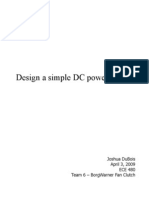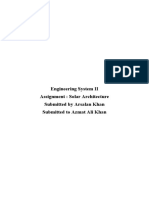Jagannath B. Hirkude, Atul S. Padalkar: Highlights
Jagannath B. Hirkude, Atul S. Padalkar: Highlights
Uploaded by
Kumar GauravCopyright:
Available Formats
Jagannath B. Hirkude, Atul S. Padalkar: Highlights
Jagannath B. Hirkude, Atul S. Padalkar: Highlights
Uploaded by
Kumar GauravOriginal Description:
Original Title
Copyright
Available Formats
Share this document
Did you find this document useful?
Is this content inappropriate?
Copyright:
Available Formats
Jagannath B. Hirkude, Atul S. Padalkar: Highlights
Jagannath B. Hirkude, Atul S. Padalkar: Highlights
Uploaded by
Kumar GauravCopyright:
Available Formats
Performance optimization of CI engine fuelled with waste fried oil
methyl ester-diesel blend using response surface methodology
Jagannath B. Hirkude
a,b,
, Atul S. Padalkar
c
a
Department of Mechanical Engineering, Sinhgad College of Engineering, Pune, 41 Maharashtra, India
b
Padre Conceicao College of Engineering, Verna, 403722 Goa, India
c
Department of Mechanical Engineering, Flora Institute of Technology, Pune, Maharashtra, India
h i g h l i g h t s
Experiments were designed using design of experiments based on RSM.
Effect of operating parameters on performance and emissions of CI engine.
Biodiesel from waste fried oil used as fuel for analysis.
Optimization of input parameters using desirability approach of RSM.
Optimal input parameters found were CR = 17.99, IP = 250 bar and IT = 27 BTDC.
a r t i c l e i n f o
Article history:
Received 10 May 2013
Received in revised form 12 November 2013
Accepted 18 November 2013
Available online 8 December 2013
Keywords:
Optimization
Performance
Waste fried oil methyl ester
Response surface methodology
a b s t r a c t
The objective of this work is to optimize direct injection, single cylinder diesel engine with respect to
brake power, fuel economy and smoke emissions through experimental investigation and response
surface methodology. A single cylinder 3.8 kW engine was selected for this experimentation. Three
parameters viz. compression ratio (CR), injection pressure (IP) and injection timing (IT) were varied
and the responses like brake thermal efciency (BTE), Brake Specic Fuel Consumption (BSFC), Exhaust
Gas Temperature (EGT) and smoke opacity (OP) were investigated. Statistical tool like response surface
methodology was used to design experiments. Optimization of compression ratio and injection system
parameters was performed using the desirability approach of the RSM for superior performance and
lesser smoke emissions. A CR of 17.99, IP of 250 bar, and IT of 27 BTDC were found to be optimal values
for the Waste Fried Oil Methyl Esters (WFOME) blended with diesel fuel operation in the test engine of 5
HP at 1500 rpm. The results of this study revealed that at optimal input parameters, the values of the BTE,
BSFC, EGT and smoke opacity were found to be 29.76%, 0.289 kg/kW h, 298.52 C and 56.49 HSU
respectively.
2013 Elsevier Ltd. All rights reserved.
1. Introduction
Alternate fuels like biodiesel for compression ignition engines
are earning popularity due to the depleting nature of fossil fuels
and adverse environmental effect of exhaust emissions from petro-
leum fuelled diesel engines. Currently elevated cost of biodiesel
produced from edible and non-edible oil is one of the main
obstructions for its commercialization. Since the cost of vegetable
oil is increasing rapidly, it is of concern to biodiesel producers as
feed stock accounts for 70% cost of biodiesel [1]. Waste cooking
oil is one of the major wastes generated in hotels and other public
eateries. Depending on the source and availability, the cost of
waste cooking oil is about 60% less than fresh vegetable oil [2].
Hence biodiesel from waste fried oil can be used as a suitable alter-
native for mineral diesel in CI engine after improvement of fuel
properties [36]. Many authors have conrmed from their primary
experimental investigations that fuel with blend of B40 (40% bio-
diesel + 60% mineral diesel) gave better performance over other
blend ratios [710]. Pandian et al. investigated the effect of injec-
tion system parameters such as injection pressure (IP), injection
timing (IT) and nozzle tip protrusion on performance and emission
characteristics of a twin cylinder compression ignition (CI) direct
injection (DI) engine fuelled with pongamia biodieseldiesel blend
using response surface methodology (RSM). The results demon-
strated that the brake specic energy consumption (BSEC), Carbon
0016-2361/$ - see front matter 2013 Elsevier Ltd. All rights reserved.
http://dx.doi.org/10.1016/j.fuel.2013.11.039
Corresponding author at: Department of Mechanical Engineering, Padre
Conceicao College of Engineering, Verna, Goa, India. Tel.: +91 9822347923;
fax: +91 832 2791268.
E-mail address: jhirkude@yahoo.com (J. B. Hirkude).
Fuel 119 (2014) 266273
Contents lists available at ScienceDirect
Fuel
j our nal homepage: www. el sevi er . com/ l ocat e/ f uel
Mono-oxide (CO), Unburned Hydrocarbon (HC) and smoke opacity
(OP) were lesser, and brake thermal efciency (BTE) and Nitrogen
Oxides (NO
x
) were higher at nozzle tip protrusion of 2.5 mm, IP of
225 bar and IT of 30 BTDC [10].
Laguitton et al. studied the effect of reduction in compression
ratio (18.4 to 16) on the emissions of a diesel engine [11]. It was
found that, either reducing the compression ratio (CR) or decreas-
ing the IT greatly reduced OP and NO
x
emissions, although there
was a small CO and HC penalty. Raheman and Ghadge analyzed
the performance of diesel engine using biodiesel by varying CRs
(18, 19 and 20). The results depicted that BTE and Exhaust Gas
Temperature (EGT) increased and Brake Specic Fuel Consumption
(BSFC) decreased with the increase in CR [12].
Puhanet al. examined the effect of variation in IP on the perfor-
mance and emissions characteristics of a diesel engine by using
high linolenic linseed oil methyl ester [13]. It was found that at
optimum IP, the values of BSFC and BTE were found similar to
those when using diesel and also a reduction in OP, CO, and HC
emissions with an increase in NO
x
emissions were observed com-
pared to diesel.
Bakar et al. investigated the effect of IP on the performance of a
DI diesel engine at 1600 rpm and they found that the best perfor-
mance was at 22 MPa, IP [14]. Hyun Kyu Suh conducted experi-
mental analysis for a better understanding of the combustion
stability and reduction of exhaust emission in low CR engine. It
was observed that two pilot injectors improve combustion ef-
ciency, and result in more stable operation in a low CR engine [15].
Suryawanshi and Desphande studied the effects of decreased
fuel IT (by 4) on the emissions and performance of a pongamia
oil methyl ester (PME) fueled DI diesel engine [16]. They observed
that the addition of PME to diesel fuel caused a signicant
reduction in OP, HC and CO emissions but a slight increase in
NO
x
emissions with standard IT. Sayin et al. studied the inuence
of CR and injection parameters such IT and IP on the performance
and emissions of a DI diesel engine using biodiesel (5%, 20%, 50%,
and 100%) blended-diesel fuel. Tests were carried out using three
different CRs (17, 18, and 19/1), ITs (15, 20, and 25 Crank Angle
(CA) Before Bottom Dead Centre (BTDC)) and IPs (18, 20 and
22 MPa) at 20 N m engine load and 2200 rpm. Their observations
revealed the best results for BSFC and BTE at increased the CR, IP,
and original IT. For the all tested fuels, an increase in IP, IT and
CR lead to decrease in OP, CO and HC emissions while increase in
NO
x
emissions [17].
The most extensive applications of RSM are in those situations
where several input variables potentially inuence some perfor-
mance measure or the quality characteristic of the process. RSM
has been applied for optimization of several chemical and
physical processes [1820]. Initially, RSM was developed to model
experimental responses and then migrated into the modeling of
numerical experiments [21]. Win et al. optimized parameters like
load, speed and static injection timing of a diesel fueled CI engine
to reduce noise, fuel consumption and exhaust emissions by using
RSM [22]. Lee and Reitz used RSM to optimize a high speed DI
diesel engine equipped with a common rail injection system
neglecting the interactive effects of the parameters [23]. Satake
et al. performed optimization of the fuel injection control of diesel
engines using RSM [24]. Anand and Karthikeyan optimized the
engine parameters of a spark ignition engine with gaseous fuels
with the help of Taguchi methodology [25]. The nonlinear
optimization techniques such as RSM, articial neural network,
genetic algorithm fuzzy logic and Taguchi method were used for
optimizing the performance and emission characteristics of diesel
engine [2527].
As seen in literature review CR, IT and IP inuences perfor-
mance and exhaust emission parameters. Some researchers have
studied effect of these parameters independently. Combined
effects of operating parameters such as CR and injection parame-
ters like IT and IP on the smoke emissions and performance of a
diesel engine using Waste Fried Oil Methyl Esters (WFOME)
blended diesel fuel have not been studied in detail. Therefore this
study highlights the combined effects of CR, IT, IP on the engine
performance and smoke emissions by using RSM. The other objec-
tive of the present work is to investigate appropriate input param-
eters (CR, IP and IT) for optimal output response parameters (BTE,
BSFC, EGT and OP) to design CI engines for specic biodiesel. Opti-
mization of input parameters was performed by using desirability
approach of RSM.
2. Equipments and material
2.1. Fuel preparations
As conrmed by initial investigation carried out by the different
authors, blend of B40 was selected because of its better perfor-
mance over other blend ratios [710]. The biodiesel produced
through transesterication process from waste fried oil was
blended with diesel, procured from a commercial vendor. A vol-
ume ratio of 40:60 is used to get the biodieseldiesel blend of
B40. To ensure a homogeneous mixture the blending was done just
before beginning of the experiments. The properties of the fuel
blend of B40 and diesel have been determined as per the ASTM
standards in an industrial testing and analytical laboratory, estab-
lished at Goa, India. The properties of B40 are tabulated in Table 1.
2.2. Engine set up
The experimental set up consists of a single cylinder diesel
engine, air metering unit, fuel measuring equipment, smoke meter
and thermocouples with temperature indicator. The schematic dia-
gram of test setup is shown in Fig. 1.This unit is manufactured by
Ind Labs Equipments Bangalore, India. The major specications of
the engine used for investigations are presented in Table 2. The en-
gine was coupled with a single phase, 230 V AC alternators. The
alternator was used for loading the engine through a resistive load
bank. The load bank consists of eight heaters of 500 W each. The
engine was loaded gradually from 0.5 kW to 3 kW in step of
0.5 kW. The engine was rst tested with diesel fuel for no load
for 20 min at rated speed of 1500 rpm until lubricating oil temper-
ature rose to around 80 C. The same conditions were maintained
throughout the experiment for different test runs.
The specic fuel consumption was computed by measuring the
time taken for a xed volume of fuel that ows into the engine. The
current and voltage was measured by using ammeter and voltme-
ter. The alternator was calibrated for its conversion efciency. The
brake power was calculated from the alternator output and its con-
version efciency. The engine speed (rpm) was measured by elec-
tronic digital counter. The readings were taken three times for each
run and the average value was used to calculate performance
parameters and smoke opacity. The performance parameters, BTE
and BSFC were calculated from measured data. The Smoke Opacity
(OP) was measured by using smoke meter (Make:Netel, India;
Table 1
Properties of B40 (test fuel).
Properties B40 Diesel (No. 2) Method
Viscosity at 400 C (cSt) 5.56 4.320 ASTM D445
Specic gravity 0.846 0.830 ASTM D941
Caloric value (kJ/kg) 41,400 43,000 ASTM D240
Flash point C 120 70 ASTM D93
J. B. Hirkude, A.S. Padalkar / Fuel 119 (2014) 266273 267
Model Name: NPM-SM-111B). The smoke opacity was measured in
Hartridge Smoke Unit (HSU).
All tests were conducted at electrical loading of 3 kW (75% of
full load capacity). All together 36 tests were conducted by varying
CR at four levels (16, 17, 18 and 19), IP at three levels (200 bar,
225 bar and 250 bar) and IT at three levels (24 BTDC, 27 BTDC
and 30 BTDC). All tests were conducted for fuel blend of B40.
Uncertainty analysis of measured and calculated parameters is
presented in Table 3.
2.3. Response surface methodology (RSM)
RSM was applied in the present study for modeling and analysis
of response parameters in order to obtain the characteristics of the
engine. The ranges of the input parameters were selected based on
the permissible limits within which the modications can be made
with the existing engine. Design of Experiments was used to eval-
uate the performance of the engine over the entire range of varia-
tion of input parameters with minimum number of experiments.
The design matrix was selected based on the historical data of
RSM generated from the software Design expert trial version
8.0.7.1 of Stat ease, US. Experimental design matrix along with re-
sponses obtained is presented in Table 4. The responses such as
BTE, BSFC were evaluated where as EGT and OP was measured.
The experimental readings were tted to the second order polyno-
mial equation using design expert software. A multiple regression
analysis was carried out to obtain coefcients and the equations
that can be used to predict the responses. Using the statistically
signicant model, the correlation between the operating parame-
ters and the several responses were obtained. Finally the optimal
values of engine operating parameters were evaluated by using
the desirability based approach of RSM.
2.4. Desirability approach for optimization
The optimization analysis can be carried out using Design
Expert software, where each response is transformed to a dimen-
sionless desirability value (d) and it ranges between d = 0, which
suggests that the response is completely unacceptable, and d = 1
suggests that the response is more desirable. The goal of each re-
sponse can be either maximize, minimize, target, in the range
and/or equal to depending on the nature of the problem. The desir-
ability of the each response can be calculated by the following
equations with respect to the goal of each response.
For a goal of minimum, d
i
= 1 when Y
i
6 Low
i
; d
i
= 0 when
Y
i
PHigh
i
; and
d
i
High
i
Y
i
=High
i
Low
i
wti
when Low
i
< Y
i
< High
i
For a goal of maximum, d
i
= 0 when Y
i
6 Low
i
; d
i
= 1 when
Y
i
PHigh
i
; and
d
i
Y
i
Low
i
=High
i
Low
i
wti
when Low
i
< Y
i
< High
i
For a goal as target, d
i
= 0 when Y
i
< Low
i
; Y
i
> High
i
d
i
Y
i
Low
i
=T
i
Low
i
wt1i
when Low
i
< Y
i
< T
i
d
i
Y
i
High
i
=T
i
High
i
wt2i
when T
i
< Y
i
< High
i
For the goal within the range, d
i
= 1 when Low
i
< Y
i
< High
i
; and
d
i
= 0; otherwise.
Here i indicates the response, Y the value of response, Low
represents the lower limit of the response, High represents the
upper limit of the response, T means the target value of the re-
sponse, wt indicates the weight of the response. The shape of
the desirability function can be changed for each response by the
weight eld. Weights are used to give more emphasis to the low-
er/upper bounds. Weights can be ranged from 0.1 to 10; a weight
greater than 1 gives more emphasis to the goal, weights less than
1 give less emphasis. When the weight value is equal to one, the
desirability function varies in a linear mode. Solving of multiple re-
sponse optimizations using the desirability approach involves a
technique of combining multiple responses into a dimensionless
measure of performance called the overall desirability function, D
(0 6 D 6 1), is calculated by
D P
n
i1
d
ri
i
1=Rri
In the overall desirability objective function (D), each response can
be assigned an importance (r), relative to the other responses.
Importance varies from the least important value of 1, indicated
1
2
3
7
8
4
10
11
9
5
6
Fig. 1. Schematic diagram of experimental setup (1) engine (2) alternator (3)
electrical load bank (4) fuel tank (5) burette (6) two way control valve (7) air box (8)
orice plate (9) U tube manometer (10) exhaust gas thermocouple, and (11) smoke
meter.
Table 2
Engine specications.
Make Kirloskar (India)
Type 4 Stroke, single cylinder
Ignition Compression ignition
Rated power 3.78 kW (5 HP)
Rated speed 1500 rpm
Number of cylinders 1
Bore X stroke 80 110 mm
Compression ratio 16.5:1
Combustion chamber Direct injection with bowl in piston
Standard injection timing 27 BTDC
Standard injection pressure 190 Bars
Starting Hand cranking
Loading By AC single phase alternator, 4 kW (max.)
Torque arm distance 0.2 m
Table 3
Accuracy and uncertainty analysis.
Measured quantity Accuracy Calculated
quantity
Uncertainty
Viscosity 0.2 cSt Brake power 2%
Time 0.1 S BTE 2.15%
EGT 1 C BSFC 2.15%
Smoke opacity 1 HSU Specic gravity 1.5%
Caloric value 0.15 MJ/
kg
Speed 10 rpm
Current 0.1 A
Voltage 5 V
Burette fuel measurement 1 cc
268 J. B. Hirkude, A.S. Padalkar / Fuel 119 (2014) 266273
by (+), the most important value of 5, indicated by (+++++). A high
value of D indicates the more desirable and best functions of the
system which is considered as the optimal solution. The optimum
values of factors are determined from value of individual desired
functions (d) that maximizes D [10].
3. Results and discussion
3.1. Analysis and evaluation of model
The Analysis of Variance (ANOVA) was used to verify model
adequacy which provides numerical information about P value.
Based on the ANOVA, the models were found to be signicant as
the values of P were less than 0.05. The regression statistics
goodness of t (R
2
) and the goodness of prediction (Adjusted R
2
)
indicated that the model ts the data very well.
The predicted quadratic models for the responses were devel-
oped in terms of non-dimensional coded factors and are given
below as Eqs. (1)(4). These equations are valid for input variables
levels range from 16 to 19 for CR, 200 to 250 bar for IP and 2430
BTDC for IT. To simplify calculations and analysis, the actual
variable ranges are usually transformed to non-dimensional coded
variables with a range of 1. In this analysis, the actual range of
16 6 CR 6 19 would translate to coded range of 1 6 CR
c
6 1.
The general equation used to translate from coded to uncoded is
given below as Eq. (5).
BTE 29:33 0:70CR
c
0:97IP
c
0:59IT
c
0:04 CR
c
IP
c
0:27 CR
c
IT
c
0:07 IP
c
IT
c
0:65
CR
2
c
0:83 IP
2
c
1:4 IT
2
c
1
BSFC 0:3 8:85 10
3
CR
c
7:5 10
3
IP
c
6:42
10
3
IT
c
5:5 10
4
CR
c
IP
c
1:65 10
3
CR
c
IT
c
3:12 10
4
IP
c
IT
c
5:68 10
3
CR
2
c
4:92 10
3
IP
2
c
0:014IT
2
c
2
EGT 297:24 14:5CR
c
4:62IP
c
5:04IT
c
0:48 CR
c
IP
c
2:52 CR
c
IT
c
0:88 IP
c
IT
c
2:63
CR
2
c
0:21 IP
2
c
0:46 IT
2
c
3
OP 59:93 3:33CR
c
1:96IP
c
2:25IT
c
0:025 CR
c
IP
c
0:3 CR
c
IT
c
IP
c
IT
c
0:13 CR
2
c
0:21
IP
2
c
0:083 IT
2
c
4
x
actual
x
min
x
coded
1=2 x
max
x
min
5
where x
actual
is the uncoded value, x
min
and x
max
are the uncoded
minimum and maximum values (corresponding to 1 and +1 coded
values), and x
coded
is the coded value to be translated. It may be
noted from Eq. (5) that the coded value of 0 corresponds to the
actual value
xmaxx
min
2
. Thus codedvalueof 0fromequations givenabove
corresponds to the following actual values: CR = 17.5, IP = 225 bar
and IT = 27 BTDC. Hence it is expected that corresponding output
gives some numerical values even when coded factors have a value
of 0. Correspondingoutput numerical values for codedvalue of 0from
the above equations are BTE = 29.33%, BSFC = 0.3 kg/kW h,
EGT = 297.24 C and OP = 59.93 HSU.
Table 4
Design matrix.
Std Run CR IP (bar) IT (BTDC) BTE (%) BSFC (kg/kW h) EGT (oC) OP (HSU)
1 1 16 200 24 24.85 0.341 282 68
2 2 16 200 27 26.32 0.32 285 65
3 3 16 200 30 25.64 0.332 288 63
4 4 16 225 24 26.43 0.329 277 66
5 5 16 225 27 27.96 0.311 281 63
6 6 16 225 30 27.4 0.317 284 61
7 7 16 250 24 26.57 0.326 274 64
8 8 16 250 27 27.85 0.309 276 61
9 9 16 250 30 27.28 0.316 279 59
10 10 17 200 24 25.7 0.331 293 65
11 11 17 200 27 25.57 0.313 297 64
12 12 17 200 30 26.23 0.323 301 60
13 13 17 225 24 27.24 0.322 288 64
14 14 17 225 27 28.91 0.303 291 61
15 15 17 225 30 28.27 0.311 296 59
16 16 17 250 24 27.35 0.318 285 62
17 17 17 250 27 28.9 0.301 288 59
18 18 17 250 30 28.2 0.307 291 57
19 19 18 200 24 26.08 0.327 301 63
20 20 18 200 27 28.29 0.303 306 61
21 21 18 200 30 27 0.313 313 59
22 22 18 225 24 27.78 0.313 297 61
23 23 18 225 27 30.08 0.291 302 59
24 24 18 225 30 29.29 0.297 309 57
25 25 18 250 24 27.89 0.309 294 59
26 26 18 250 27 29.95 0.289 298 57
27 27 18 250 30 29.15 0.294 303 55
28 28 19 200 24 25.85 0.329 306 61
29 29 19 200 27 27.95 0.305 314 59
30 30 19 200 30 26.62 0.313 325 57
31 31 19 225 24 25.59 0.315 301 58
32 32 19 225 27 29.69 0.293 308 56
33 33 19 225 30 29.12 0.299 319 54
34 34 19 250 24 27.75 0.313 298 57
35 35 19 250 27 29.55 0.291 305 55
36 36 19 250 30 29.05 0.297 309 53
J. B. Hirkude, A.S. Padalkar / Fuel 119 (2014) 266273 269
3.2. Interactive effect of CR and IP
BTE at different CRs and IPs is depicted in a three dimension
plot (Fig. 2a). As seen in gure, for all IPs, the BTE increases with
increase in CR (from 16 to 18) and decreases slightly with further
increase in CR (from 18 to 19). At IT of 27 BTDC, increase CR from
16 to 17 and from 17 to 18 increased BTE by 2.61%, and 3.54%
respectively. Further, increase in CR from 18 to 19 lead to decrease
in BTE by 0.384%. The minimum auto-ignition temperature of a
fuel decreases due increased density of the compressed air. This re-
sults in a closer contact between the molecules of fuel and oxygen
reducing the time of reaction. The increase in the compression
temperature as well as the decrease in minimum auto-ignition
temperature decreases the delay period [28]. Initial increase in
BTE with increase in CR could be attributed to enhancement of
density of intake air and reduction in ignition delay associated with
it. Minor reduction in BTE beyond compression ratio of 18 could be
attributed to insufcient combustion space because of further
reduction in clearance volume. Small (insufcient) combustion
chamber volume causes the injected fuel particles to hit to com-
bustion chamber wall and may lead to incomplete combustion
[10]. The change in BSFC at different IPs and CRs is presented in
Fig. 2b. As illustrated in gure the BSFC was found decreasing with
increase in CR from 16 to 18. The possible reason for this trend
could be that, with an increase in CR, the maximum cylinder pres-
sure increases due to the fuel injected in hotter combustion cham-
ber and this leads to higher effective power. Therefore, fuel
consumption per output power will decrease [29]. From CR of 18
onwards minor increase in BSFC was observed. The possible reason
for this trend could be insufcient combustion space (because of
very less clearance volume at higher CR), which leads to slight
reduction in effective power. The variation of EGT for different
CRs and IPs is shown in Fig. 2c. At higher CRs increase in EGT
was observed and the possible reason for this could be higher oper-
ating temperature at elevated CRs [2]. The interactive effect of CR
and IP on OP is depicted in Fig. 2d. Smoke emissions at higher
CRs were observed lesser than at lower CRs. This could be because
of better combustion efciency due to higher temperature and
pressure at higher CRs [30].
3.3. Interactive effect of IP and IT
As seen in Fig. 3a, the BTE increases with increase in injection
pressure. Higher fuel injection pressures increase the degree of
atomization. The neness of atomization reduces ignition delay,
due to higher surface volume ratio [30]. At 27 BTDC, with increase
in IP from 200 to 225 bar, average BTE increased by 3.41%. Further,
increase in IP from 225 to 250 bar, leads to increase in BTE just by
0.88%. This could be because of improved spray characteristics,
better atomization and good mixing with air at higher IPs. This will
improve efciency because of enhancement in combustion pro-
cess. A very high IP leads to ner diameter of fuel droplet; this af-
fects the spray pattern and penetration. Too ne droplet size will
have low depth of penetration due to less momentum of the drop-
let and velocity relative to air from where it has to nd oxygen
after vaporization [30]. Therefore only minor increase in BTE was
observed from 225 to 250 bar IP. The other reason for negligible
improvement in efciency could be that beyond 225 bar pressure,
faster velocity of fuel jets caused most fuel particles to hit the wall
of combustion chamber where fuel particles get cooled which may
Fig. 2. Interactive effect of IP and CR.
270 J. B. Hirkude, A.S. Padalkar / Fuel 119 (2014) 266273
result in incomplete combustion [9]. Fig. 3b demonstrates the
change in BSFC at different IPs and ITs. The reduced BSFC values
were obtained with increase in IP (from 200 to 225 bar). This could
be because of ner atomization and improved mixing at higher
injection pressure [31]. Marginal decrease in BSFC was observed
with increase in IP from 225 to 250 bar because of minor increase
in BTE. Brake specic energy consumption at CR of 17 (for 27
0
BTDC and 200 bar) was 12,960 kJ/kW h.
Variation in EGT with different IPs and ITs is shown in Fig. 3c.
There was increase in EGT with increase in IP. This may be attrib-
uted to the increased cylinder pressure due to improved combus-
tion of fuel as a result of improved atomization and better
mixing [31].
Fig. 3d explains variation in OP at different IPs and ITs. Decrease
in OP with increase in IP was observed. This could be, as a result of
ner particle diameter at higher IP. Therefore, fuel-mixture would
become better through the combustion period which leads to less
smoke emission [30].
3.4. Interactive effect of IT and CR
The change in BTE at different ITs and CRs is observed in Fig. 4a.
BTE decreases with advancement of IT from 27 BTDC to 30 BTDC,
even retardation of IT from 27 BTDC to 24 BTDC leads to decrease
in BTE. This can be attributed to increase ignition delay associated
with increase in injection time angle. Whereas retardation of injec-
tion timing by 3 (24 BTDC) decreases delay period which could
lessen the brake power due to burning of larger quantity of fuel
during expansion [2].
The variation of BSFC for different CRs and ITs is shown in
Fig. 4b. At CR of 18 with increase in IT from 24 to 27 BTDC leads
to decrease in average BSFC by 6.95%. While further increase in
IT from 27 to 30 BTDC resulted in increase in BSFC by 2.37%. With
advancement of IT from 27 BTDC to 30 BTDC the ignition delay
would be longer and ame speed may be lower. These cause reduc-
tion in brake power. But retardation of IT from 27 BTDC to
24 BTDC leads to late combustion and therefore pressure rises at
a later stage of the expansion stroke. These cause reduction in
effective pressure which could be responsible for reduction in
brake power and reduction in BSFC [2]. BSEC at 27 BTDC (for CR
of 18 and IP of 250 bar) observed was 12,050 kJ/kW h.
Fig. 4c illustrates effects of IT and CR on EGT. As seen in Fig. 4c,
decrease in EGT was observed with increase in IT. Advancement of
injection timings may lead to an early start of combustion relative
to TDC which increases chances of complete combustion and
reduces the EGT [2]. Fig. 4d explains the variation of OP for differ-
ent ITs and CRs. Because of advancement of injection timings from
24 BTDC to 30 BTDC, OP was reduced. Finer break up fuel drop-
lets obtained with increased IP provide more surface area and bet-
ter mixing with air and this effect improves combustion [18]. As
the pressure and temperature at the beginning of the injection
are lower for higher ignition advance, the delay period increases
with increase in injection advance [28]. This could be attributed
to the following fact: advancement of injection timing means ex-
tended ignition and decrease in charge temperature and pressure
[2].
3.5. Optimization
The comprehensive discussions on the effect of CR, IP and IT on
performance and smoke emission characteristics have shown that
the lowest IP of 200 bar, retarded IT of 24 BTDC and CR of 16
Fig. 3. Interactive effect of IT and IP.
J. B. Hirkude, A.S. Padalkar / Fuel 119 (2014) 266273 271
resulted in low values of BTE and EGT with high values of BSFC
and OP. An IP of 250 bar with an IT of 27 BTDC and CR of 18 caused
higher BTE and EGT with lower values of BSFC and OP. Optimisa-
tion of individual performance and emission parameters for
independent input variables like CR, IP and IT are tabulated in
Table 5.
As there was a trade-off between BTE, BSFC, OP and EGT, it was
necessary to optimize the CR, IP and IT with the goal of minimizing
smoke emission and maximizing the BTE without compromising
BSFC and EGT. The criteria for the optimization such as the goal
set for each response, lower and upper limits used, weights used
and importance of the factors is shown in Table 6. In desirability
Fig. 4. Interactive effect of IT and CR.
Table 5
Optimization of individual parameters.
Parameter Optimized value Criteria CR IP (bar) IT (BTDC) Desirability
BTE (%) 29.946 Maximize 18.43 240.41 27.97 0.974
BSFC (kg/kW h) 0.288 Minimize 18.67 237.79 27.62 1.000
EGT (C) 274.98 Minimize 16.00 250.00 24.00 0.981
OP (HSU) 52.902 Minimize 18.99 249.99 29.93 1.000
Table 6
Optimization criteria and desirability of responses for performance parameters.
Parameter Limits Weight Importance Criterion Desirability
Lower Upper Lower Upper
CR 16 19 1 1 3 In range 1
IP (bar) 225 250 1 1 3 In range 1
IT (BTDC) 27 30 1 1 3 In range 1
BTE (%) 20 30.86 0.1 1 5 Maximize 0.93
BSFC (kg/kW h) 0.289 0.341 1 0.1 5 Minimize 0.956
EGT (C) 274 325 1 0.1 5 Minimize 0.519
OP (HSU) 53 68 1 0.1 5 Minimize 0.769
Combined 0.778
272 J. B. Hirkude, A.S. Padalkar / Fuel 119 (2014) 266273
based approach the solution with high desirability was favoured.
Maximum desirability of 0.778 was obtained at CR of 17.99, IT of
27.8 BTDC and IP of 250 bar, which could be considered as the
optimum parameters. BSEC at optimal input parameters was ana-
lysed as 11,970 kJ/kW h.
4. Conclusions
In this study biodiesel from waste fried oil blended with min-
eral diesel was used to investigate effects of signicant operating
parameters like CR, IT and IP on performance and emission of com-
pression ignition engine. Based on the results of this study the fol-
lowing conclusion can be drawn.
1. RSM based design of experiments was used to design and carry
out statistical analysis to determine parameters which have the
most signicant inuence on the performance and smoke emis-
sion characteristics. Desirability approach of the RSM was used
to nd out optimum parameters for optimization of perfor-
mance and smoke emission characteristics.
2. Increase in compression ratio increases brake thermal efciency
for all injection pressures and injection timings of the engine.
Beyond CR of 18, decrease in trend in BTE was observed. Brake
thermal efciency was found to increase with increase in injec-
tion pressure. Maximum brake thermal efciency was observed
with original engine injection timing.
3. Initial decrease in BSFC was observed with increase in CR (from
16 to 18) and then starts increasing (from 18 to 19). Minimum
BSFC was observed at original injection timing of 27 BTDC.
With increase in IP there was decrease in BSFC. Intensity of
decrease in BSFC from 225 to 250 bar injection pressure was
marginal.
4. EGT was found to increase with increase in CR and IP, while EGT
was observed decreasing with increase in IT. OP was reduced at
higher CR. It was seen that advancement in injection timing
lead to reduced smoke emissions. Decrease in OP with increase
in IP was also observed.
5. At optimum input parameters viz. CR of 17.99, IP of 250 bar
with IT of 27 BTDC, the values of the BTE, BSFC, EGT and smoke
opacity were found to be 29.76%, 0.289 kg/kW h, 298.52 C and
56.49 HSU respectively.
6. By properly controlling CR, IP and IT, performance can be
improved and smoke emissions can be controlled by using a
blend of alternate fuel like biodiesel from waste fried oil.
References
[1] Hirkude JB, Padalkar AS. Performance and emission analysis of a compression
ignition engine operated on waste fried oil methyl esters. Appl Energy
2012;90:6872.
[2] Shivakumar Srinivasa Pai P, Shrinivasa Rao BR. Articial Neural Network based
prediction of performance and emission characteristics of a variable
compression ratio CI engine using WCO as a biodiesel at different injection
timings. Appl Energy 2011;88:234454.
[3] Zheng S, Khates M, Dube MA. Acid-catalyzed production of biodiesel from
waste frying oil. Biomass Bioenergy 2006;30:26772.
[4] Tomasevic AV, Siler-Marinkovic SS. Methanolysis of used frying oil. Fuel
Process Technol 2006;81:16.
[5] Mustafa Canakci, Necati Ozsezen. Evaluating waste cooking oils as alternative
diesel fuel. GU J Sci 2005;18:8191.
[6] Zafer Utlu, Sureyya Kocak Mevlut. Effect of biodiesel obtained from waste
cooking oil on diesel engine performance and exhaust emissions. Renew
Energy 2008;33:193641.
[7] Agarwal AK, Rajamanoharan K. Experimental Investigations of performance
and emissions of Karanja oil and its blends in a single cylinder agricultural
diesel engine. Appl Energy 2009;86:10612.
[8] Raheman H, Phadatare AG. Diesel Engine emissions and performance from
blends of karanja methyl ester and diesel. Biomass Bioenergy vol. 27, p. 393
97.
[9] Sureshkumar K, Velraj R, Ganesan R. Performance and Emission
characteristicsof a CI engine fuelled with Pongamia methyl ester and its
blends with diesel. Renew Energy 2008;33:2294302.
[10] Pandian M, Sivapirakasam SP, Udayakumar M. Investigation on the effect of
injection system parameters on performanceand emission characteristics of a
twin cylinder compression ignition direct injection engine fuelled with
pongamia biodieseldiesel blend using response surface methodology. Appl
Energy 2011;88:266376.
[11] Laguitton C, Crua T, Cowell T, Gold MR. The effect of compression ratio on
exhaust emissions from a PCCI diesel engine. Energy Convers Manage
2007;48:291824.
[12] Raheman H, Ghadge SV. Performance of diesel engine with biodiesel at varying
compression ratio and ignition timing. Fuel 2008;87:265966.
[13] Puhan S, Jegan R, Balasubbramanian K, Nagarajan G. Effect of injection
pressure on performance, emissions, and combustion characteristics of
highlinolenic linseed oil methyl ester in a DI diesel engine. Renew Energy
2009;34:122733.
[14] Bakar RA, Ismail S, Ismail AR. Fuel injection pressure effect on performance of
direct injection diesel engine. Am J Appl Sci 2008;5:197202.
[15] Kyu Suh Hyun. Investigations of multiple injection strategies for the
improvement of combustion and exhaust emissions characteristics in a low
compression ratio (CR) engine. Appl Energy 2011;88:50139.
[16] Suryawanshi JG, Desphande NV. Effect of injection timing retard on emissions
and performance of a Pongamia oil methyl ester fueled with CI engine. SAE
Tech Paper 2005;01:3677.
[17] Sayin Cenk, Gumus Metin. Impact of compression ratio and injection
parameters on the performance and emissions of a DI diesel engine fueled
with biodieselblended diesel fuel. Appl Therm Eng 2011;31:31828.
[18] Jeong GT, Yang HS, Park DH. Optimization of transesterication of animal fat
ester using response surface methodology. Bioresour Technol
2009;100:2530.
[19] Halim SFA, Kamaruddin AH, Fernando WJN. Continuous biosynthesis of
biodiesel from waste cooking palm oil in a packed bed reactor: optimization
using response surface methodology (RSM) and mass transfer studies.
Bioresour Technol 2009;100:7106.
[20] Hameed BH, Lai LF, Chin LH. Production of biodiesel from palm oil
(Elaeisguineensis) using heterogeneous catalyst: an optimized process. Fuel
Process Technol 2009;90:60610.
[21] Box GEP, Draper NR. Empirical model-building and response surfaces. New
York: John Wiley & Sons; 1987.
[22] Win Z, Gakkar RP, Jain SC, Bhattacharya M. Parameter optimization of a diesel
engine to reduce noise, fuel consumption, and exhaust emissions using
response surface methodology. Proc Inst Mech Eng Part D: J Automob Engg
2005;219:118192.
[23] Lee T, Reitz RD. Response surface method optimization of a high speed direct
injection diesel engine equipped with a common rail injection system. ASME J
Eng Gas Turb Power 2003;125:5416.
[24] Satake K, Monaka T, Yamada S, Endo H, Yamagisawa M, Abe T. The rapid
development of diesel engine using an optimization of the fuel injection
control. Mitsubishi Heavy Indus Limit Tech Rev 2008;45:610.
[25] Ganapathy T, Murugesan K, Gakkar RP. Performance optimization of Jatropha
biodiesel engine model using Taguchi approach. Appl Energy
2009;86:247686.
[26] Karuppasamy K, Syed Abu Thaheer A, Ahmed Basha C. The effect of biodiesel
blends on single cylinder DI diesel engine and optimization using response
surface methodology. Eur J Scient Res 2012;84:36576.
[27] Alonso JM, Alvarruiz F, Desantes JM, Hernandez L, Hernandez V, Molto G.
Combining neural networks and genetic algorithms to predict and reduce
diesel engine emission. IEEE Trans Evolut Comput 2008;11:4655.
[28] Ganeshan V. Internal combustion engines. New Delhi: Tata McGraw Hills;
2008.
[29] Ulusoy Y, Tekin Y, Cetinkaya M, Karaosmanoglu F. The engine tests of biodiesel
from used frying oils. Energy Sources 2004;26:92732.
[30] Celik MB. Experimental determination of suitable ethanol-gasoline blend rate
at high compression ratio for gasoline engine. Appl Therm Eng
2008;28:396404.
[31] Jindal S, Nandwana BP, Rathore NS, Vashistha V. Experimental investigation of
the effect of compression ratio and injection pressure in a DI diesel engine
running on Jatropha methyl ester. Appl Therm Eng 2010;30:4428.
J. B. Hirkude, A.S. Padalkar / Fuel 119 (2014) 266273 273
You might also like
- Non-Conventional Energy Sources by G D RaiDocument713 pagesNon-Conventional Energy Sources by G D RaiVS Deepak Rajpurohit91% (226)
- M. Pandian, S.P. Sivapirakasam, M. Udayakumar: SciencedirectDocument14 pagesM. Pandian, S.P. Sivapirakasam, M. Udayakumar: SciencedirectKumar GauravNo ratings yet
- Ethanol PaperDocument22 pagesEthanol PaperMuhammad Imran KhanNo ratings yet
- Biodiesel-Blended Diesel FuelDocument7 pagesBiodiesel-Blended Diesel FuelVaibhav MoonNo ratings yet
- Reducing Diesel EngineDocument10 pagesReducing Diesel EngineNaliana LupascuNo ratings yet
- Arabian JournalDocument21 pagesArabian Journalsudhansu sekhar mishraNo ratings yet
- 149 Ijmperdfeb2018149Document12 pages149 Ijmperdfeb2018149TJPRC PublicationsNo ratings yet
- Studying The Effect of Compression Ratio On An Engine Fueled With Waste Oil Produced Biodiesel/diesel FuelDocument11 pagesStudying The Effect of Compression Ratio On An Engine Fueled With Waste Oil Produced Biodiesel/diesel FuelSuresh ThillaiNo ratings yet
- Experimental Investigations On Single Cylinder 4-Stroke Diesel Engine Using NanofuelsDocument5 pagesExperimental Investigations On Single Cylinder 4-Stroke Diesel Engine Using NanofuelsT Hari PrasadNo ratings yet
- V1i10 Ijertv1is10248 PDFDocument7 pagesV1i10 Ijertv1is10248 PDFmechveenaNo ratings yet
- Effect of Supercharging On Engine PerformanceDocument13 pagesEffect of Supercharging On Engine PerformanceanshurathoreNo ratings yet
- Effect of Piston Bowl Geometry On The Performance of ADocument9 pagesEffect of Piston Bowl Geometry On The Performance of AMuhammad RonaldoNo ratings yet
- 27377-Article Text-101616-1-10-20210901Document9 pages27377-Article Text-101616-1-10-20210901Aro NiainaNo ratings yet
- Engine Fueled With Mahua Biodiesel Blends Effect of Combustion Chamber Geometry On Performance and Emission Characteristics of A DieselDocument5 pagesEngine Fueled With Mahua Biodiesel Blends Effect of Combustion Chamber Geometry On Performance and Emission Characteristics of A DieselSundaraPandiyanNo ratings yet
- Googd3-The Effects of Fuel Injection Pressure On Combustion and Emission Characteristics of A Diesel Engine Using Frying Oil Methyl EsterDocument18 pagesGoogd3-The Effects of Fuel Injection Pressure On Combustion and Emission Characteristics of A Diesel Engine Using Frying Oil Methyl EsterBalaji BhukyaNo ratings yet
- Energies 12 01547Document36 pagesEnergies 12 01547Ahmed OmarNo ratings yet
- Performance and Emission Parameters Analysis of Gasoline Engine With EGRDocument5 pagesPerformance and Emission Parameters Analysis of Gasoline Engine With EGRIJERDNo ratings yet
- Parametric Optimization of Engine Performance and Emission For Various N-Butanol Blends at Different Operating Parameter ConditionDocument14 pagesParametric Optimization of Engine Performance and Emission For Various N-Butanol Blends at Different Operating Parameter ConditionAnbarasan RaviNo ratings yet
- IJERD (www.ijerd.com) International Journal of Engineering Research and Development IJERD : hard copy of journal, Call for Papers 2012, publishing of journal, journal of science and technology, research paper publishing, where to publish research paper, journal publishing, how to publish research paper, Call For research paper, international journal, publishing a paper, how to get a research paper published, publishing a paper, publishing of research paper, reserach and review articles, IJERD Journal, How to publish your research paper, publish research paper, open access engineering journal, Engineering journal, Mathemetics journal, Physics journal, Chemistry journal, Computer Engineering, how to submit your paper, peer review journal, indexed journal, reserach and review articles, engineering journal, www.ijerd.com, research journals, yahoo journals, bing journals, International Journal of Engineering Research and Development, google journals, journal of engineering, online SubmisDocument9 pagesIJERD (www.ijerd.com) International Journal of Engineering Research and Development IJERD : hard copy of journal, Call for Papers 2012, publishing of journal, journal of science and technology, research paper publishing, where to publish research paper, journal publishing, how to publish research paper, Call For research paper, international journal, publishing a paper, how to get a research paper published, publishing a paper, publishing of research paper, reserach and review articles, IJERD Journal, How to publish your research paper, publish research paper, open access engineering journal, Engineering journal, Mathemetics journal, Physics journal, Chemistry journal, Computer Engineering, how to submit your paper, peer review journal, indexed journal, reserach and review articles, engineering journal, www.ijerd.com, research journals, yahoo journals, bing journals, International Journal of Engineering Research and Development, google journals, journal of engineering, online SubmisIJERDNo ratings yet
- 4 Stroke SI Engine Using CNG PDFDocument4 pages4 Stroke SI Engine Using CNG PDFAdish AmboreNo ratings yet
- Effect of Inlet Air Temperature On Combustion, Performance and Emissions of Gasoline Direct Injection (Gdi) Engine Fuelled by LPG FuelDocument13 pagesEffect of Inlet Air Temperature On Combustion, Performance and Emissions of Gasoline Direct Injection (Gdi) Engine Fuelled by LPG Fuelhuynh9249No ratings yet
- 2 67 1583133695 24ijmperdapr202024Document12 pages2 67 1583133695 24ijmperdapr202024TJPRC PublicationsNo ratings yet
- Literature SurveyDocument6 pagesLiterature SurveySrikanth DesaiNo ratings yet
- Performance and Emission Evaluation of A CI Engine Fueled With Preheated Raw Rapeseed Oil (RRO) - Diesel BlendsDocument5 pagesPerformance and Emission Evaluation of A CI Engine Fueled With Preheated Raw Rapeseed Oil (RRO) - Diesel BlendsRamnarayan MeenaNo ratings yet
- Performance Combustion and Emission Characteristics On DI Diesel Engine Using Bio AdditiveDocument6 pagesPerformance Combustion and Emission Characteristics On DI Diesel Engine Using Bio AdditiveSetiyo WibisonoNo ratings yet
- Energies 08 07312Document14 pagesEnergies 08 07312Otello EvolutionNo ratings yet
- Full Length Article: Contents Lists Available atDocument11 pagesFull Length Article: Contents Lists Available atAndreea MadalinaNo ratings yet
- Statistical Analysis of The Effect of CME-Diesel Blends On The Performance of A Light Duty Common Rail Direct Injection EngineDocument12 pagesStatistical Analysis of The Effect of CME-Diesel Blends On The Performance of A Light Duty Common Rail Direct Injection Engineburnt_mallowsNo ratings yet
- Jurnal Petrokimia Ivan AbrorDocument10 pagesJurnal Petrokimia Ivan AbrorMuhamad Ivan AbrorNo ratings yet
- 3146 Naturalvolatilesessentialoils Vol+8+iss+5Document17 pages3146 Naturalvolatilesessentialoils Vol+8+iss+5Hoi TranNo ratings yet
- Effect of Inlet Air Temperature On HCCI Engine Fuelled With Diesel - Eucalyptus Fuel BlendsDocument8 pagesEffect of Inlet Air Temperature On HCCI Engine Fuelled With Diesel - Eucalyptus Fuel BlendsIJRASETPublicationsNo ratings yet
- Performance Evaluation of A Constant Speed IC Engine On CNG, Methane Enriched PDFDocument9 pagesPerformance Evaluation of A Constant Speed IC Engine On CNG, Methane Enriched PDFRamnarayan MeenaNo ratings yet
- Project Report NewDocument14 pagesProject Report NewAbhishek SinghNo ratings yet
- Ju 18Document16 pagesJu 18Sherin Novia Dwi PareraNo ratings yet
- Performance Evaluation of Rice Brawn Oil in Low Grade Low Heat Rejection Diesel EngineDocument12 pagesPerformance Evaluation of Rice Brawn Oil in Low Grade Low Heat Rejection Diesel EngineresearchinventyNo ratings yet
- A Critical Review On Hydrogen-Diesel Fuel Mode Compression Ignition EngineDocument5 pagesA Critical Review On Hydrogen-Diesel Fuel Mode Compression Ignition EngineSeyedNo ratings yet
- 1 s2.0 S0016236119323981 MainDocument16 pages1 s2.0 S0016236119323981 MainBalaji BhukyaNo ratings yet
- Compression RatioDocument15 pagesCompression RatioVenkateshNo ratings yet
- Exhaust Gas Recirculation ReportDocument21 pagesExhaust Gas Recirculation ReportJignesh Rohit100% (2)
- Experimental Analysis of Engine Performance and Combustion Characteristics Using Dual Biodiesel BlendsDocument7 pagesExperimental Analysis of Engine Performance and Combustion Characteristics Using Dual Biodiesel BlendsMadhurjya SaikiaNo ratings yet
- Energy: Abhishek Paul, Raj Sekhar Panua, Durbadal Debroy, Probir Kumar BoseDocument15 pagesEnergy: Abhishek Paul, Raj Sekhar Panua, Durbadal Debroy, Probir Kumar Boseroad1212No ratings yet
- Study of Air Inlet Preheating and EGR Impacts For Improving The Operation of Compression Ignition Engine Running UnderDocument14 pagesStudy of Air Inlet Preheating and EGR Impacts For Improving The Operation of Compression Ignition Engine Running UnderEsa Nur ShohihNo ratings yet
- Studying The Performance of Pongamia Biodiesel by Using Nano Partical Fuel AdditivesDocument6 pagesStudying The Performance of Pongamia Biodiesel by Using Nano Partical Fuel Additivessemi1919No ratings yet
- Performance and Emission Characteristics of CI Engine With Methyl Esters of Palm Stearin Under Varying Compression Ratios and Fuel Injection PressuresDocument9 pagesPerformance and Emission Characteristics of CI Engine With Methyl Esters of Palm Stearin Under Varying Compression Ratios and Fuel Injection PressuresT Hari PrasadNo ratings yet
- Dissertation 1newDocument37 pagesDissertation 1newShailesh PrajapatiNo ratings yet
- 231 JT339Document5 pages231 JT339Vinoth Kumar VinsNo ratings yet
- Ijmet 08 06 010 PDFDocument11 pagesIjmet 08 06 010 PDFLatifah HanumNo ratings yet
- Experimental Investigation On Performance and Emissions Characteristic of Dedicated CNG EngineDocument8 pagesExperimental Investigation On Performance and Emissions Characteristic of Dedicated CNG EngineTJPRC PublicationsNo ratings yet
- Diesel Engine Performance and Emission Analysis Using Mosambi Peelpyro Oil With Nano Additive ParticlesDocument6 pagesDiesel Engine Performance and Emission Analysis Using Mosambi Peelpyro Oil With Nano Additive ParticlesTJPRC PublicationsNo ratings yet
- Loganathan 2018Document51 pagesLoganathan 2018Hendrick ZarateNo ratings yet
- Ijaiem 2014 09 24 53Document11 pagesIjaiem 2014 09 24 53International Journal of Application or Innovation in Engineering & ManagementNo ratings yet
- Effect of Injector Opening Pressure On Performance, Combustion and EmissionDocument9 pagesEffect of Injector Opening Pressure On Performance, Combustion and EmissionIAEME PublicationNo ratings yet
- Ijmet: ©iaemeDocument11 pagesIjmet: ©iaemeIAEME PublicationNo ratings yet
- Nagesh 2018 IOP Conf. Ser.: Mater. Sci. Eng. 376 012002 PDFDocument7 pagesNagesh 2018 IOP Conf. Ser.: Mater. Sci. Eng. 376 012002 PDFAri SetiawanNo ratings yet
- 1 s2.0 S2214785315002941 MainDocument10 pages1 s2.0 S2214785315002941 MainBalaji BhukyaNo ratings yet
- 2014 CK Nayak Et Al. EFFECT OF PREHEATED JATROPHA OIL AND JATROPHA OIL METHYL ESTER WITH PRODUCER GAS ON DIESEL ENGINE PERFORMANCEDocument14 pages2014 CK Nayak Et Al. EFFECT OF PREHEATED JATROPHA OIL AND JATROPHA OIL METHYL ESTER WITH PRODUCER GAS ON DIESEL ENGINE PERFORMANCEBP PattanaikNo ratings yet
- Ijmet: ©iaemeDocument11 pagesIjmet: ©iaemeIAEME PublicationNo ratings yet
- Fuels 03 00017Document20 pagesFuels 03 00017vikram29586No ratings yet
- N 8Document10 pagesN 8ekremNo ratings yet
- An Experimental Investigation of The Performance Indicators of Gasoline Engine With Octane Number AdditiveDocument7 pagesAn Experimental Investigation of The Performance Indicators of Gasoline Engine With Octane Number AdditiveInternational Journal of Innovative Science and Research TechnologyNo ratings yet
- Natural Gas Processing from Midstream to DownstreamFrom EverandNatural Gas Processing from Midstream to DownstreamNimir O. ElbashirNo ratings yet
- Prop. Petrol Diesel Viscosity @40oc Sp. Gravity Calorific Value (KJ/KG) Flash Point ©Document14 pagesProp. Petrol Diesel Viscosity @40oc Sp. Gravity Calorific Value (KJ/KG) Flash Point ©Kumar GauravNo ratings yet
- Form Community CollegeDocument3 pagesForm Community CollegeKumar GauravNo ratings yet
- Fractional Factorial With Foldover Tutorial: DX8 03C Foldover - Docx Rev. 6/7/10Document22 pagesFractional Factorial With Foldover Tutorial: DX8 03C Foldover - Docx Rev. 6/7/10Kumar GauravNo ratings yet
- Affidavit by The Parent/GuardianDocument1 pageAffidavit by The Parent/GuardianKumar GauravNo ratings yet
- Revised Figs of ANFISDocument3 pagesRevised Figs of ANFISKumar GauravNo ratings yet
- Neural Network, Sewage TreatmentDocument10 pagesNeural Network, Sewage TreatmentKumar GauravNo ratings yet
- Neural Network Tool Box Operation in MATLABDocument4 pagesNeural Network Tool Box Operation in MATLABKumar GauravNo ratings yet
- Ann PDFDocument17 pagesAnn PDFKumar GauravNo ratings yet
- Affidavit by The StudentDocument1 pageAffidavit by The StudentKumar GauravNo ratings yet
- Ee IIDocument7 pagesEe IIKumar GauravNo ratings yet
- Geography 9 PDFDocument63 pagesGeography 9 PDFKumar GauravNo ratings yet
- IntroductionDocument18 pagesIntroductionKumar GauravNo ratings yet
- PGT Unit 6.4Document14 pagesPGT Unit 6.4Dr. Anand SatputeNo ratings yet
- LCU Power Transducer FPWK-201Document2 pagesLCU Power Transducer FPWK-201Ganesh Kumar ArumugamNo ratings yet
- 100AH BatteriesDocument2 pages100AH BatteriesAlbert MantizaNo ratings yet
- Component List For Electrics: Technical SpecificationDocument36 pagesComponent List For Electrics: Technical SpecificationIvica Tomic BambaNo ratings yet
- Oxygen Sensors Oxygen Sensor Adjustment - General InformationDocument13 pagesOxygen Sensors Oxygen Sensor Adjustment - General InformationKlaudio OidualkNo ratings yet
- Chemistry The Central Science 14th Edition Brown Test Bank 1Document36 pagesChemistry The Central Science 14th Edition Brown Test Bank 1jaclynsanchezphdgrocpaiysj100% (32)
- Parallel GeneratorsDocument4 pagesParallel GeneratorsMariam FatimaNo ratings yet
- Heating and Air Conditioning Ent.: 220V/1/60Hz Total Power (W) MOP Ref. Motor Oty. Item Model E.HDocument3 pagesHeating and Air Conditioning Ent.: 220V/1/60Hz Total Power (W) MOP Ref. Motor Oty. Item Model E.Hrazi khanNo ratings yet
- What Is Energy CouplingDocument16 pagesWhat Is Energy Couplingjoei ArqueroNo ratings yet
- Current TransformerDocument28 pagesCurrent TransformerNarasimma BabuNo ratings yet
- Hydro-Power Generation For A Water Treatment System and Method of Supplying Electricity Using A Flow of LiquidDocument8 pagesHydro-Power Generation For A Water Treatment System and Method of Supplying Electricity Using A Flow of LiquidRianna RamosNo ratings yet
- Unit 4Document19 pagesUnit 4Camille CannonNo ratings yet
- MDCAT SOS Live Lectures (Revised)Document3 pagesMDCAT SOS Live Lectures (Revised)Ahmed MujtabaNo ratings yet
- Power Supply DesigningDocument7 pagesPower Supply DesigningmarczzzNo ratings yet
- DC Power Cable Installation Rectifier, Battery, DWDMDocument16 pagesDC Power Cable Installation Rectifier, Battery, DWDMHanhan RohandaNo ratings yet
- ENA Forum MembershipDocument4 pagesENA Forum MembershipA14 SungNo ratings yet
- HRSGDocument4 pagesHRSGnivasssv100% (1)
- Li (2020) - Analysis of Air Compression Progress of Compressor and Control For Optimal Enenrgy Efficiency in PEMFCDocument21 pagesLi (2020) - Analysis of Air Compression Progress of Compressor and Control For Optimal Enenrgy Efficiency in PEMFCGeonhui GwakNo ratings yet
- Pine Briquette EfficiencyDocument5 pagesPine Briquette EfficiencyRajat BhatiaNo ratings yet
- Kyung-Jin Boo - New & Renewable Energy Policy FIT Vs RPSDocument23 pagesKyung-Jin Boo - New & Renewable Energy Policy FIT Vs RPSAsia Clean Energy ForumNo ratings yet
- Obrador Activity1 ME-3205Document4 pagesObrador Activity1 ME-3205Leslie Jean ObradorNo ratings yet
- (Springer Series in Materials Science 245) Christopher R. Weinberger, Garritt J. Tucker (Eds.) - Multiscale Materials Modeling For Nanomechanics-Springer International Publishing (2016)Document554 pages(Springer Series in Materials Science 245) Christopher R. Weinberger, Garritt J. Tucker (Eds.) - Multiscale Materials Modeling For Nanomechanics-Springer International Publishing (2016)Anonymous RuEybHNo ratings yet
- SMPSDocument3 pagesSMPSsahilfriendmailNo ratings yet
- 00-Generator Work Scope and Hazard AssessmentDocument17 pages00-Generator Work Scope and Hazard Assessmentacanbasri1980No ratings yet
- Arsalan SolarDocument11 pagesArsalan SolarHilal AhmadNo ratings yet
- MNL Solax Chint 3-Phase Dtsu666-Ct-En-1Document2 pagesMNL Solax Chint 3-Phase Dtsu666-Ct-En-1sarlasotecNo ratings yet
- Combining Photovoltaic Modules and Food Crops: First Agrovoltaic Prototype in BelgiumDocument7 pagesCombining Photovoltaic Modules and Food Crops: First Agrovoltaic Prototype in BelgiumTetiana PerederiiNo ratings yet
- M2 Conservation of Momentum (FE1073)Document10 pagesM2 Conservation of Momentum (FE1073)Ho Chong JianNo ratings yet
- Understanding Explosions - Appendix B Equations For Determining The Energy of Explosion - 2003Document4 pagesUnderstanding Explosions - Appendix B Equations For Determining The Energy of Explosion - 2003Liu YangtzeNo ratings yet







